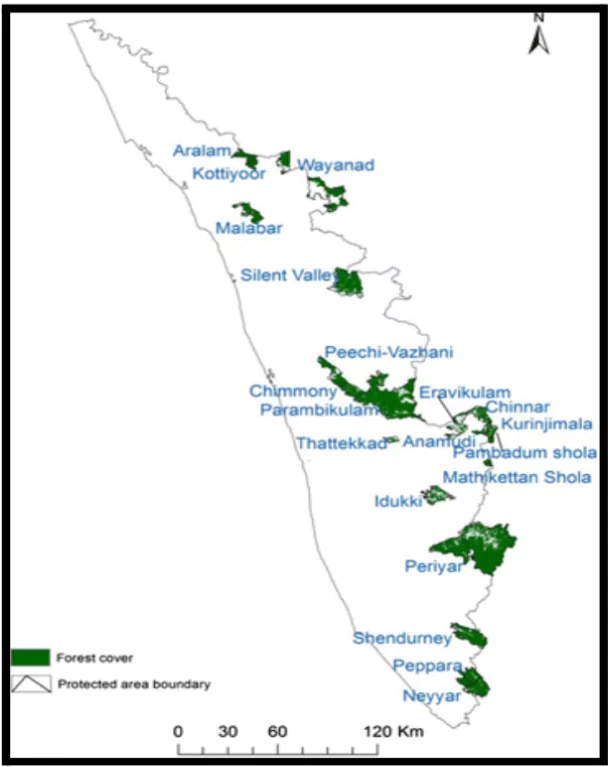A three-member team from the Standing Committee of the National Board for Wildlife (NBWL) will inspect the Thattekad Bird Sanctuary and the Angel Valley and Pamba Valley settlements in the Periyar Tiger Reserve.
- The inspection is part of a request from the State government to exclude human settlements from these protected areas.
- Residents have sought this exclusion due to the constraints wildlife laws impose on their daily lives.
National Board for Wildlife (NBWL)
- The National Board for Wildlife (NBWL) is the apex body for wildlife conservation in India.
- It was established in 2003 under the Wildlife Protection Act, 1972.
- It is chaired by the Prime Minister and advises the central and state governments on policy matters related to wildlife conservation.
- It also approves projects in and around protected areas.
|
Enroll now for UPSC Online Course
Angel Valley and Pamba Valley Settlements
- Location: Located in the eastern tip of Kottayam district, Kerala, bordering the Periyar Tiger Reserve.
- The Resident proposed to exclude 502.723 hectare of these two settlements, part of the Erumely panchayat, from the PTR buffer zone
- Primarily inhabited by descendants of ex-service personnel who were allocated land after World War II.
- Natural Features: Nestled between the Azhutha River and the Periyar Tiger Reserve, offering scenic views and lush greenery.
- However, the proximity to the reserve also poses challenges like wildlife encounters.
|
About Periyar Tiger Reserve
- Location : The reserve is located in the Western Ghats of Kerala and derives its name from the Periyar River, which originates deep within the reserve.
- Tribal Communities: The reserve is home to tribal communities, including the Mannans and the Palians, who have a deep cultural and historical connection to the area.
 Vegetation: The forest comprises tropical evergreen, semi-evergreen, and moist deciduous vegetation, supporting diverse wildlife.
Vegetation: The forest comprises tropical evergreen, semi-evergreen, and moist deciduous vegetation, supporting diverse wildlife.- Fauna: The reserve is known for species like elephants, wild pigs, sambar, gaur, mouse deer, barking deer (dole), Indian wild dog, and tigers.
- It also provides a habitat for the elusive Nilgiri Tahr, a species endemic to the Western Ghats.
- Primates: Rare primates in the reserve include the lion-tailed macaque, Nilgiri langur, Gee’s golden langur, common langur, and bonnet macaque.
Thattekad Bird Sanctuary
- Location: The sanctuary, also known as the Salim Ali Bird Sanctuary, is situated on the northern bank of the Periyar River.
- It was notified in 1983 based on a recommendation by the renowned ornithologist Dr. Salim Ali, who recognized its biodiversity and ecological significance
Check Out UPSC CSE Books From PW Store
Regulation of Activities in Different Protected Areas of India
| Protected Areas |
Regulated Activities |
| National Parks |
- Grazing of livestock is prohibited.
- No commercial exploitation of natural resources.
- Limited eco-tourism activities, regulated by management plans.
- Scientific research permitted with prior approval.
|
| Wildlife Sanctuaries |
- Grazing may be allowed in buffer areas (if specified by management plans).
- Entry for tourism regulated.
- Habitat manipulation for species conservation permitted.
- No commercial harvesting of flora or fauna.
|
| Conservation Reserves |
- Eco-tourism and regulated grazing allowed.
- Conservation of species coexists with traditional community practices.
- Development projects need approval.
|
| Community Reserves |
- Community-owned and managed.
- Sustainable harvesting of resources permitted.
- Eco-tourism and educational activities regulated by local management.
|
| Biosphere Reserves |
- Core zones: No human activity allowed except research.
- Buffer zones: Regulated agriculture, forestry, and tourism activities.
- Transition zones: Sustainable economic activities promoted, subject to guidelines.
|
| Ramsar Sites (Wetlands of International Importance) |
- Prohibited activities include drainage, landfill, and pollution discharge.
- Regulated fishing, agriculture, and tourism in alignment with the Ramsar Convention guidelines
|
| Marine Protected Areas (MPAs) |
- Prohibited activities: Trawling and destructive fishing practices.
- Regulated tourism, fishing, and aquaculture based on zonation plans.
- Oil drilling and mining activities banned in core areas.
|
| Eco-sensitive Zones (ESZs) |
- Industrial activities are restricted.
- Regulated expansion of existing infrastructure like roads and buildings.
- Prohibition of polluting activities, such as large-scale mining or manufacturing industries.
|
| Tiger Reserves |
- Core zones: Strict protection; no human activity allowed except forest department operations and research.
- Buffer zones: Limited tourism and grazing under management plan.
- No mining or large-scale development permitted.
|
| Elephant Reserves |
- Habitat corridors conserved.
- Prohibition of deforestation and mining.
- Regulation of developmental activities to maintain wildlife connectivity.
|
To get PDF version, Please click on "Print PDF" button.

 Vegetation: The forest comprises tropical evergreen, semi-evergreen, and moist deciduous vegetation, supporting diverse wildlife.
Vegetation: The forest comprises tropical evergreen, semi-evergreen, and moist deciduous vegetation, supporting diverse wildlife.